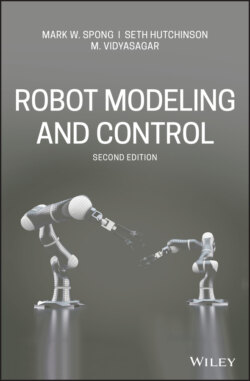Читать книгу Robot Modeling and Control - Mark W. Spong - Страница 48
Problems
Оглавление1 What are the key features that distinguish robots from other forms of automation such as CNC milling machines?
2 Briefly define each of the following terms: forward kinematics, inverse kinematics, trajectory planning, workspace, accuracy, repeatability, resolution, joint variable, spherical wrist, end effector.
3 What are the main ways to classify robots?
4 Make a list of 10 robot applications. For each application discuss which type of manipulator would be best suited; which least suited. Justify your choices in each case.
5 List several applications for nonservo robots; for point-to-point robots; for continuous path robots.
6 List five applications that a continuous path robot could do that a point-to-point robot could not do.
7 List five applications for which computer vision would be useful in robotics.
8 List five applications for which either tactile sensing or force feedback control would be useful in robotics.
9 Suppose we could close every factory today and reopen them tomorrow fully automated with robots. What would be some of the economic and social consequences of such a development?
10 Suppose a law were passed banning all future use of industrial robots. What would be some of the economic and social consequences of such an act?
11 Discuss applications for which redundant manipulators would be useful.
12 Referring to Figure 1.24, suppose that the tip of a single link travels a distance d between two points. A linear axis would travel the distance d while a rotational link would travel through an arc length ℓθ as shown. Using the law of cosines, show that the distance d is given by which is of course less than ℓθ. With 10-bit accuracy, ℓ = 1 meter, and θ = 90°, what is the resolution of the linear link? of the rotational link?
13 For the single-link revolute arm shown in Figure 1.24, if the length of the link is 50 cm and the arm travels 180 degrees, what is the control resolution obtained with an 8-bit encoder?
14 Repeat Problem 1–13 assuming that the 8-bit encoder is located on the motor shaft that is connected to the link through a 50:1 gear reduction. Assume perfect gears.
15 Why is accuracy generally less than repeatability?
16 How could manipulator accuracy be improved using endpoint sensing? What difficulties might endpoint sensing introduce into the control problem?
17 Derive Equation (1.11).
18 For the two-link manipulator of Figure 1.19 suppose a1 = a2 = 1.Find the coordinates of the tool when and .If the joint velocities are constant at , , what is the velocity of the tool? What is the instantaneous tool velocity when ?Write a computer program to plot the joint angles as a function of time given the tool locations and velocities as a function of time in Cartesian coordinates.Suppose we desire that the tool follow a straight line between the points (0,2) and (2,0) at constant speed s. Plot the time history of joint angles.
19 For the two-link planar manipulator of Figure 1.19 is it possible for there to be an infinite number of solutions to the inverse kinematic equations? If so, explain how this can occur.
20 Explain why it might be desirable to reduce the mass of distal links in a manipulator design. List some ways this can be done. Discuss any possible disadvantages of such designs.
Figure 1.24 Diagram for Problem 1–12, 1–13, and 1–14.
